
A note from Tanya Talaga
I’ve watched The Narwhal doggedly report on all the issues that feel even more acutely...
Editor’s note: Five days after this story was published, Mount Polley Remediation said in response to a question on its Facebook page that Imperial Metals had paid for the advertising “to show the progress that has been made by Mount Polley in response to the well-known tailings spill.”
An anonymous group called “Mount Polley Remediation” is promoting Facebook ads and videos celebrating the clean-up of one of the worst mining disasters in Canadian history, even as contaminated waste from the gold and copper mine owned by Imperial Metals continues to pour into Quesnel Lake.
“Canada is #1 once again,” proclaims one video ad, as a large Canadian flag flaps in the wind to music with a heavy drumbeat.
“We get it right most of the time and when we don’t — like at Polley Lake — we make it right,”
says the ad, which launched on October 30.
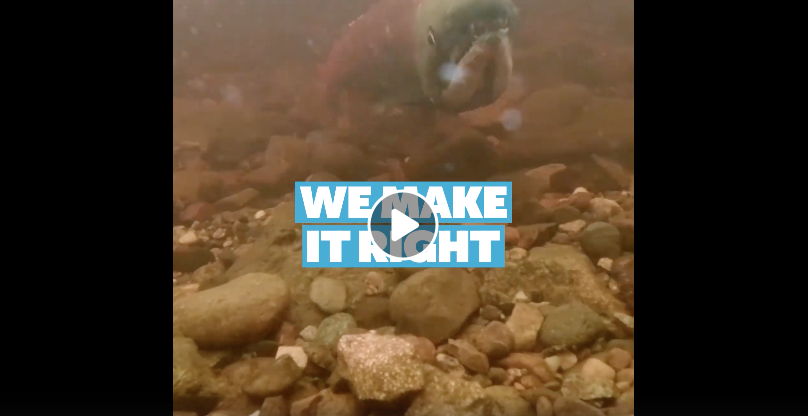
Image: Mount Polley Remediation / Facebook
“Canada has a lot to teach the world when it comes to responsible resource development.”
A separate ad celebrates the “heroes” of the clean-up, while another video posted on the group’s Facebook page — created on September 29 by an unnamed “local business” — carries the tagline “Mount Polley Remediation is celebrating recovery.”
The video, called “The Fish are Biting at Polley Lake,” informs viewers that “after intense remediation efforts, life is getting back to normal.” Footage of a salmon swimming above a stoney river bottom is followed by a cartoon of a fish jumping and splashing.
The individuals, groups or companies behind the ads or page are not listed on Facebook and two calls to Imperial Metals’ head office in Vancouver were not returned.
Christine McLean, a spokesperson for the Concerned Citizens of Quesnel Lake, said life is far from normal for people who live around Quesnel Lake, with many locals refusing to drink the water or eat fish like rainbow trout even though they catch them.
The citizens group is in the process of appealing a B.C. government permit allowing Imperial Metals each day to discharge an average of 55,500 cubic metres of mine waste contaminated with copper and other heavy metals into Quesnel Lake, which feeds into the Fraser River and is one of the world’s deepest glacial lakes.
“It can never be made right when you’re discharging your mine waste directly into what was once a pristine, salmon-bearing lake,” McLean told The Narwhal.
“The Mount Polley mine is polluting Quesnel Lake as we speak and the government has given them approval to do that. It’s unconscionable.”

In 2017 the province of B.C. approved a water treatment permit for the Mount Polley mine that included the disposal of treated mine waste water into Quesnel Lake via a discharge pipeline. On numerous occasions the mine has been found out of compliance with the conditions of this permit. Image: Province of B.C.
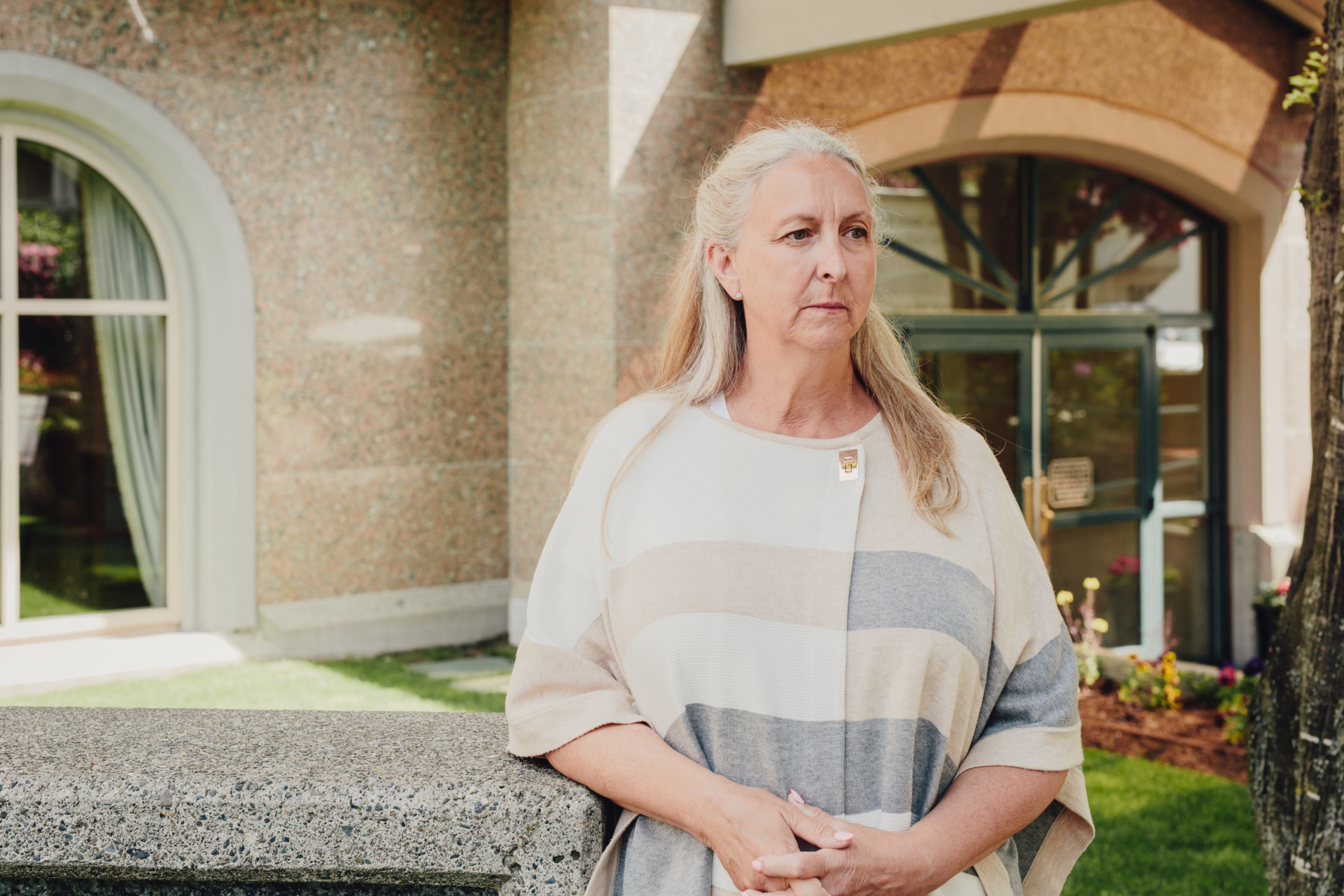
Christine McLean of the Concerned Citizens of Quesnel Lake launched an appeal against the Mount Polley mine being given a permit to pipe effluent into Quesnel Lake after the Mount Polley disaster. Photo: Taylor Roades / The Narwhal
The citizens group formed after a 2014 tailings pond breach at the mine swept 25-million cubic metres of contaminated sludge and mine waste into Polley Lake, Hazeltine Creek and Quesnel Lake, a source of drinking water for residents of Likely, B.C.
An investigation into the cause of the breach revealed mine engineers had failed to account for glacial silt underneath the tailings containment pond, leading to structural insufficiencies that caused the dam’s collapse.
No charges or fines have been laid in response to the disaster, although on July 26 the B.C. Environment Ministry served notice to the company that it is recommending a monetary penalty be levied because the company has failed to submit a detailed design for a pilot passive water treatment system, a requirement of its effluent discharge permit.
A final decision about the penalty, which usually carries a limit of $40,000 for any single contravention, will be made in late 2020, according to the ministry.
Mount Polley Mining Corporation, a subsidiary of Imperial Metals, is also out of compliance with three other conditions of its provincial permit authorizing the discharge of effluent to the land and to surface water, according to the July 26 notice the B.C. Environment Ministry sent to the company following an April inspection.
Those violations include a 2018 inspection report that failed to include the results of annual leak and pressure testing of the pipeline sending contaminated waste into Quesnel Lake.
McLean said there are no plans to stop piping mine waste into Quesnel Lake 24 hours a day as part of the company’s remediation efforts.
“There’s no talk about that in the remediation plan,” she said. “There’s no talk about the 25-million cubic metres of tailings waste that’s going to stay in the bottom of the lake because they can’t do anything with it without creating more damage.”
“There’s no talk about the tailings that are still laying throughout the valley of the Hazeltine Creek area … They talk like they’ve cleaned all the tailings up. The only place they cleaned the tailings is in the immediate area of the Hazeltine Creek.”
According to a 2015 paper published in the journal Geophysical Research Letters, the initial deposit of mine waste at the bottom of Quesnel Lake was estimated to be over 600 metres long and one kilometre wide, with a depth of one to three metres.
That approximation — roughly the size equivalent of six Manhattan-style city blocks — is thought to be underestimated, however, according to co-author Sam Albers, who said the volume of the spill was likely greater based on B.C.’s Post-Event Environmental Impact Assessment Report, released after his paper was published.
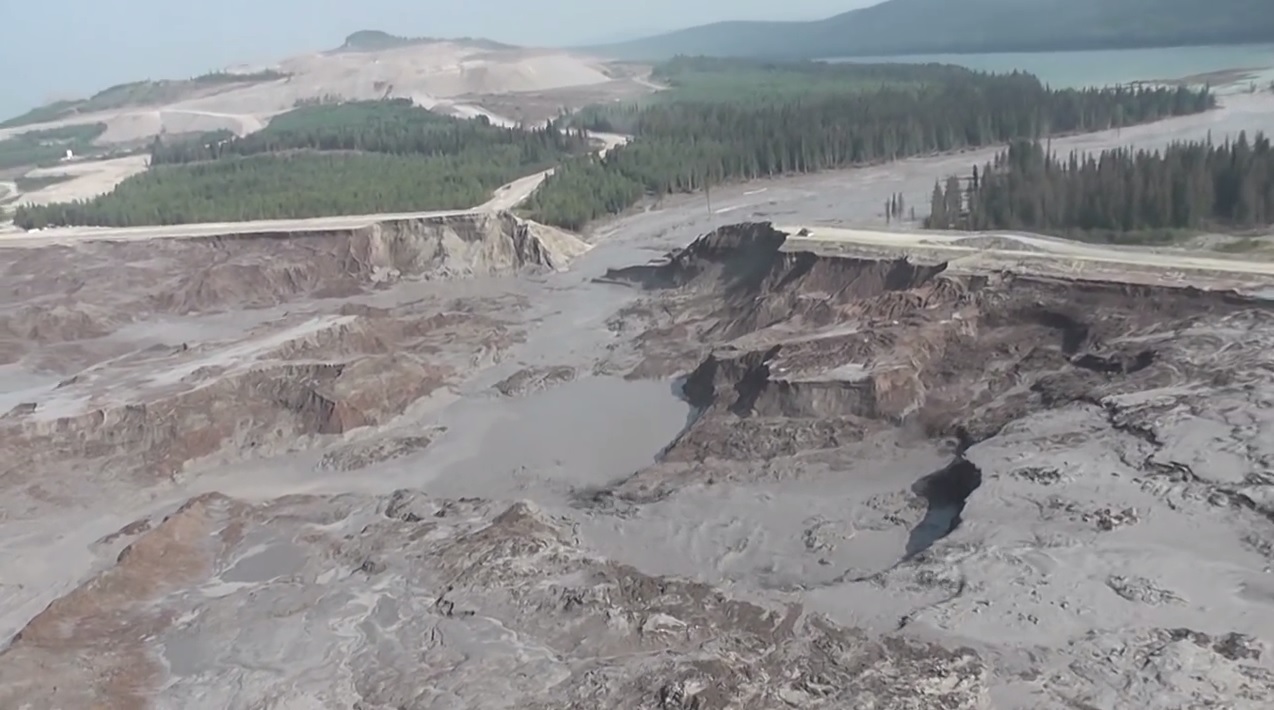
The Mount Polley mine tailings pond collapse, August 2014. Photo: Cariboo Regional District / Youtube
While Mount Polley Mining Corporation was repeatedly found to be out of compliance with the conditions of its effluent discharge permit between 2016 and 2018 — receiving 11 warnings and advisories related to that permit — company documents show top Imperial Metals executives each received a salary increase of almost $30,000 over the same time period.
Company president Brian Kynoch earned a 2018 salary of $275,000, compared to $247,500 in 2016. When total compensation was included, Kynoch earned $285,000 in 2018.
Chief financial officer André Deepwell and chief operating officer Don Parsons each earned $240,000 in 2018, also a salary increase for each of close to $30,000 over 2016.
In 2015, the year following the Mount Polley disaster, Kynoch took home more than $1 million in salary and compensation, compared to $284,500 in 2014, according to the documents.
Deepwell and Parsons each earned more than $600,000 in salary and compensation in 2015, compared to $224,000 and $226,000, respectively, in 2014.
“It doesn’t seem that the people in charge of Imperial Metals have paid any price for this,” said Jamie Kneen, communications and outreach coordinator for MiningWatch Canada.
“While Imperial Metals claims to have spent tens of millions of dollars on clean up and remediation they have not paid any fines. They have not paid any compensation to anybody.”
Kneen said research continues to determine the complex effects of tailings waste left in Quesnel Lake on salmon runs downstream.
“The problem is that the bulk of that spilled material is still in Quesnel Lake and it’s not at all clear what the effects are. And it’s not at all clear what can be done, if anything, to remediate it.”
“It seems pretty incongruous to claim that Imperial Metals is leading the way in anything really, other than public relations.”
Tailings dam failures linked to hefty bonuses for mine managers: report
The new Facebook page and ads come alongside other efforts to convey the impression that all is well following extensive remediation work undertaken by Imperial Metals.
Two months before the Facebook page was established, the industry-led group Resource Works featured a post titled “How things were made right after the Mount Polley spill.”
Written by Lyn Anglin, former chief scientific officer for Imperial Metals, the article focuses on the corporation’s efforts to repair and build fish spawning habitat for salmon and rainbow trout on Hazeltine Creek and at the mouth of Edney Creek, the main creek flowing into Quesnel Lake from the Mount Polley area.
“The company responsible did not just ‘walk away’ from the tailings spill, rather they put their heart and soul into doing their best to ‘make it right,’ and all the evidence shows that they have succeeded in putting the creek and the lake on a positive path to recovery,” Anglin wrote, noting that most remediation work was done by the company’s local employees and contractors, along with its First Nations partners.
“All indications are that the areas impacted by the Mount Polley spill are recovering well,” wrote Anglin, a geologist.
“It will no doubt take many, many years until the trees have grown to maturity, but for the forest and riparian areas along Hazeltine Creek that were impacted by the event, and the creek itself, the road to recovery appears to be well underway.”
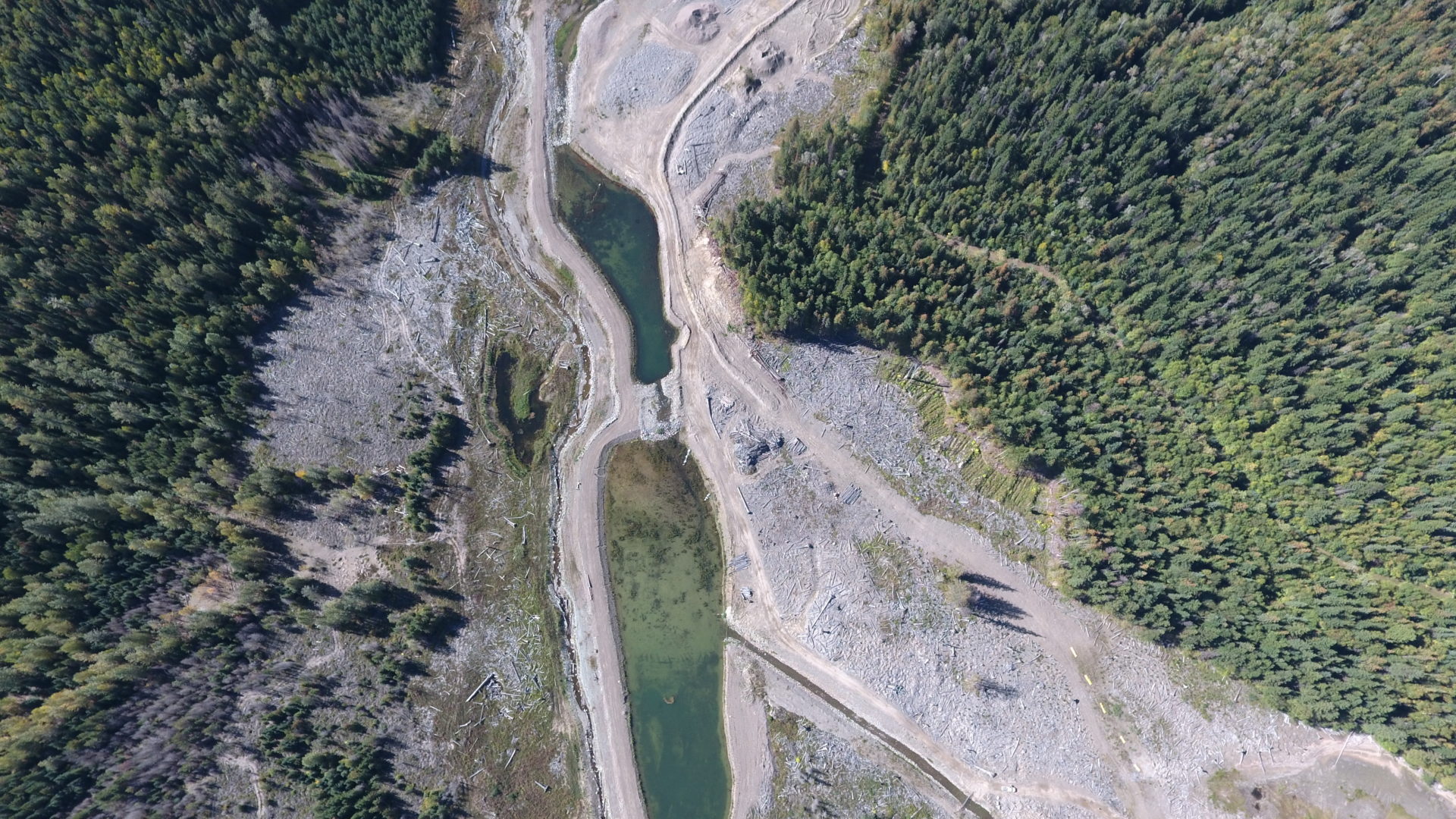
The lower portion of the remediated Hazeltine Creek in fall 2018. Photo: The Narwhal

A stake marks the pipeline that runs from Mount Polley mine’s tailings pond to the mouth of Hazeltine Creek. Photo: Louis Bockner / The Narwhal
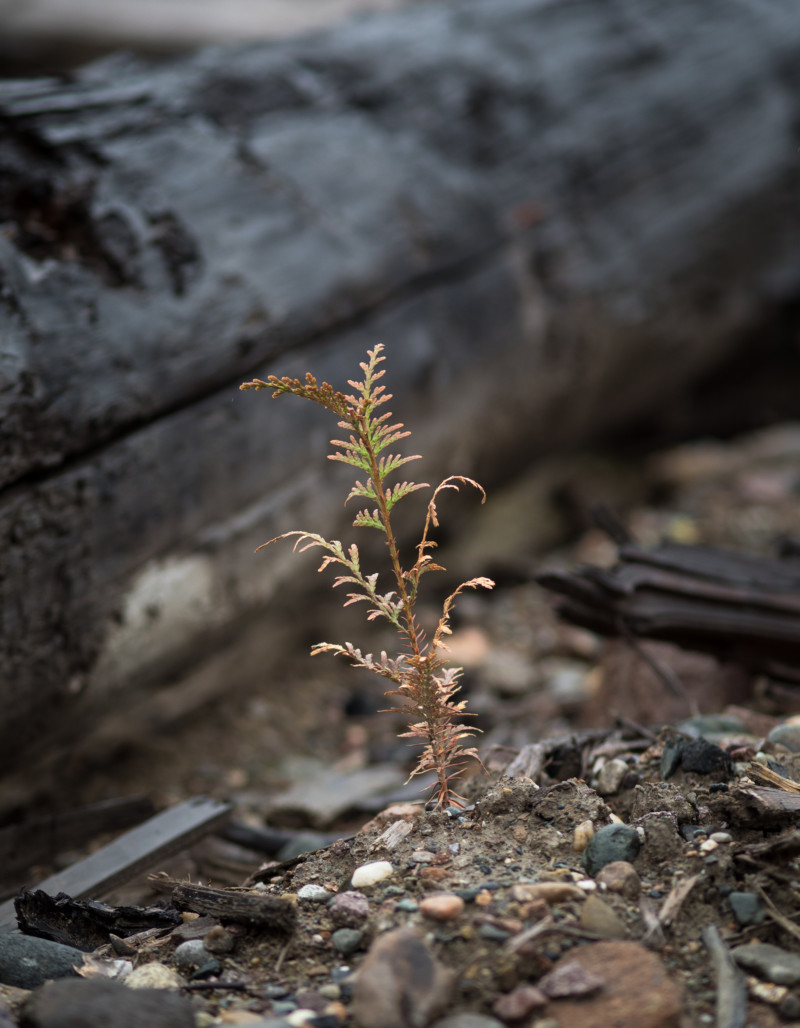
A seedling planted along the remediated Hazeltine Creek. Photo: Louis Bockner / The Narwhal

Mist rising from Quesnel Lake. Photo: Louis Bockner / The Narwhal
But MacLean said little grows along Hazeltine Creek despite remediation efforts.
“There’s this huge, huge area that’s been scoured out. It’s devoid of trees. There are a few bushes now and a little bit of grass, not much. They took all the trees that had been destroyed in the dam failure … and chipped them up into bark mulch. And then they left this bark mulch on top of the tailings.”
Imperial Metals has spent close to $70 million on environmental impact studies, remediation work and on-going monitoring of areas impacted by the spill, according to Anglin.
Taxpayers have subsidized the cleanup with almost $40 million in direct government costs and tax breaks for the company, which in January suspended operations at the Mount Polley mine, citing low copper prices.
In an emailed statement, the B.C. environment ministry said it has conducted a total of 22 Mount Polley inspections since 2015, including inspections related to the effluent discharge permit.
Six inspections found the company to be in compliance with B.C.’s Environmental Management Act and 12 resulted in advisories or warnings for infractions ranging from exceeding discharge limits to failures to report all required results.
The most recent areas of non-compliance with the discharge permit include the company’s failure to submit a draft water management plan by June 30 as required, outlining how it will address contaminants.
The ministry also said a pollution abatement order issued to the company was cancelled on September 13 because an inspection showed that “all the requirements of the order were met.”
The pollution abatement order required a plan for the long-term mitigation and remediation of impacts from the tailings spill, overseen by a fish habitat remediation working group comprised of staff from First Nations and federal and provincial agencies, according to the ministry.
“While full environmental remediation will take years, significant progress has been made in the remediation efforts done to-date,” the ministry noted.
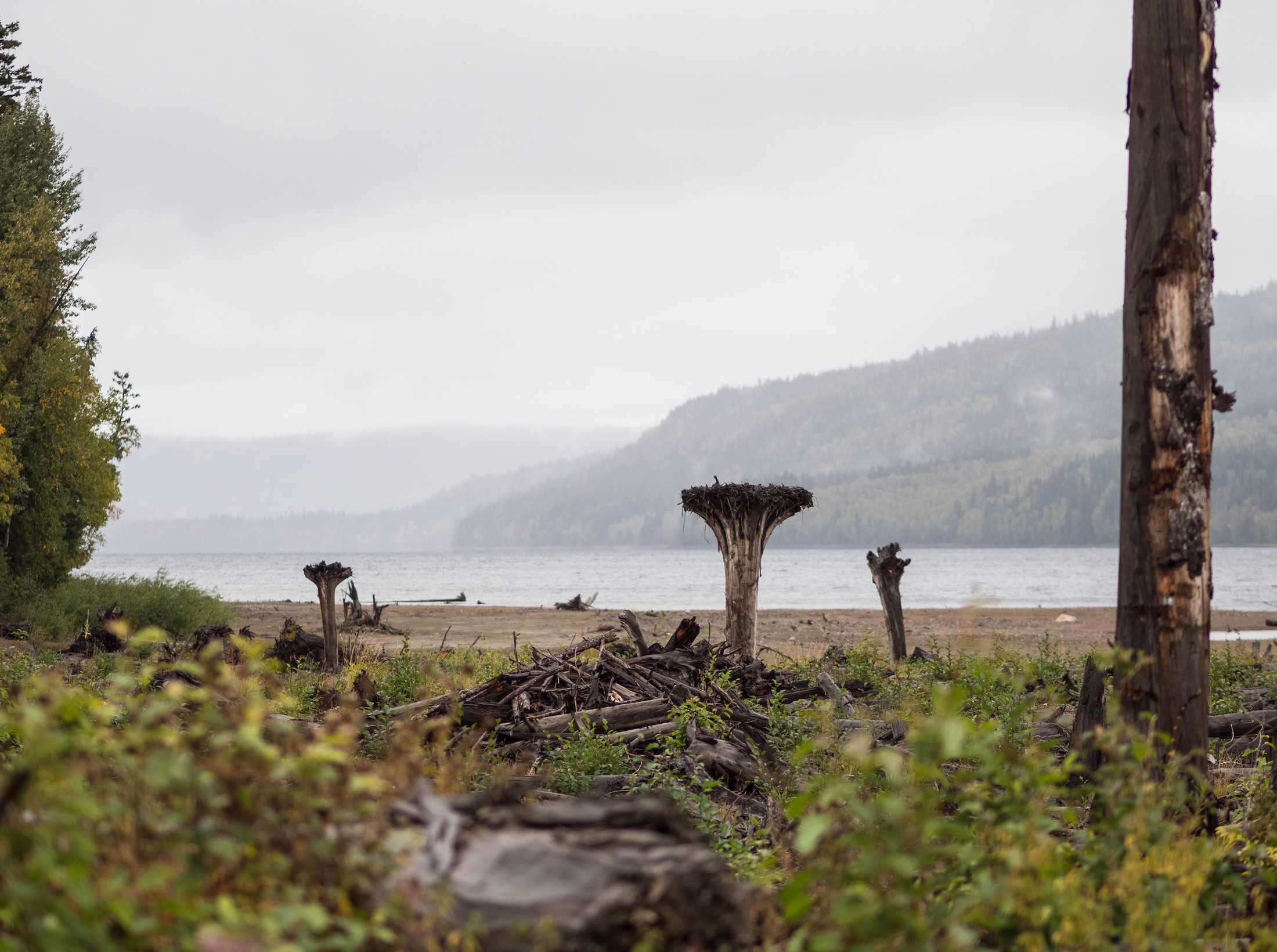
Upturned trees, placed in the ground in an effort to provide perches for birds of prey as part of remediation work at the mouth of Hazeltine Creek. Photo: Louis Bockner / The Narwhal
“The Province, with First Nation participation, has overseen all environmental remediation and monitoring work done by the company and will continue to do so.”
An engineer’s order issued under the provincial Water Act remains in place to direct the continuing restoration of the Hazeltine Creek fishery and fish habitat, the ministry said.
Prior to the recommendation for an administrative monetary penalty, the province had issued only written warnings and advisories to Imperial Metals.
Under Section 120[6] of the B.C. Environmental Management Act, a permit holder charged with an offence and convicted can face a fine of up to $1 million or imprisonment for up to six months, or both.
For that to happen, the compliance section of the Environment Ministry’s environmental protection division would have to refer the matter for an investigation, which would determine if there were grounds for charges to be laid.
“The B.C. Ministry of the Environment is very lenient with Mount Polley,” McLean said. “We don’t know why.”
The ministry said it takes an “escalating approach to non-compliance” as outlined in its Compliance and Enforcement Policy and Procedure.
“The ministry works with permit holders to help them get back into compliance, which means they are taking necessary steps to protect human health and the environment.”
The Facebook ads have appeared in advance of a November 27 open house in Likely organized by the environment ministry to discuss monitoring, recent inspection results and the company’s effluent discharge permit.
The “Mount Polley Remediation” Facebook page says “now it’s easier” to contact the group through Facebook Messenger. But The Narwhal’s message was not returned.
Imperial Metals’ Mount Polley “remediation and monitoring” website page says it’s being updated and to please check back again.
Mount Polley Administrative… by The Narwhal on Scribd
Get the inside scoop on The Narwhal’s environment and climate reporting by signing up for our free newsletter. On March 17, federal Conservative Leader Pierre Poilievre...
Continue reading
I’ve watched The Narwhal doggedly report on all the issues that feel even more acutely...

Establishing the Robinson Treaties, covering land around Lake Huron and Lake Superior, created a mess...

An internal document obtained by The Narwhal shows how the natural resources minister was briefed...
